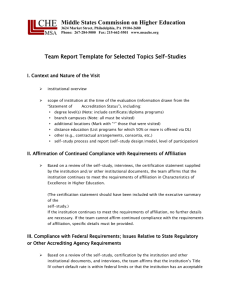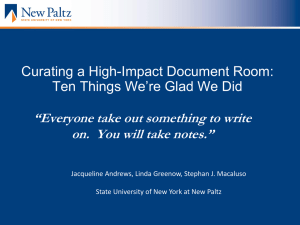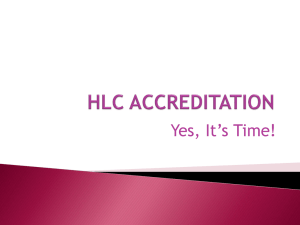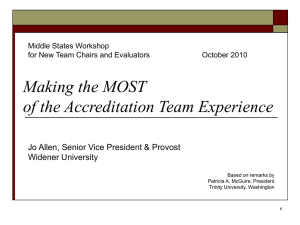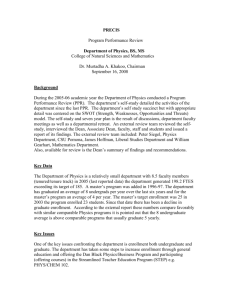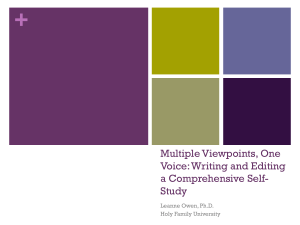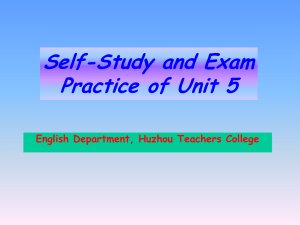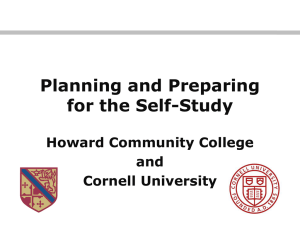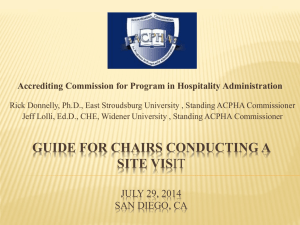Self-study Plan - West Virginia Northern Community College
advertisement
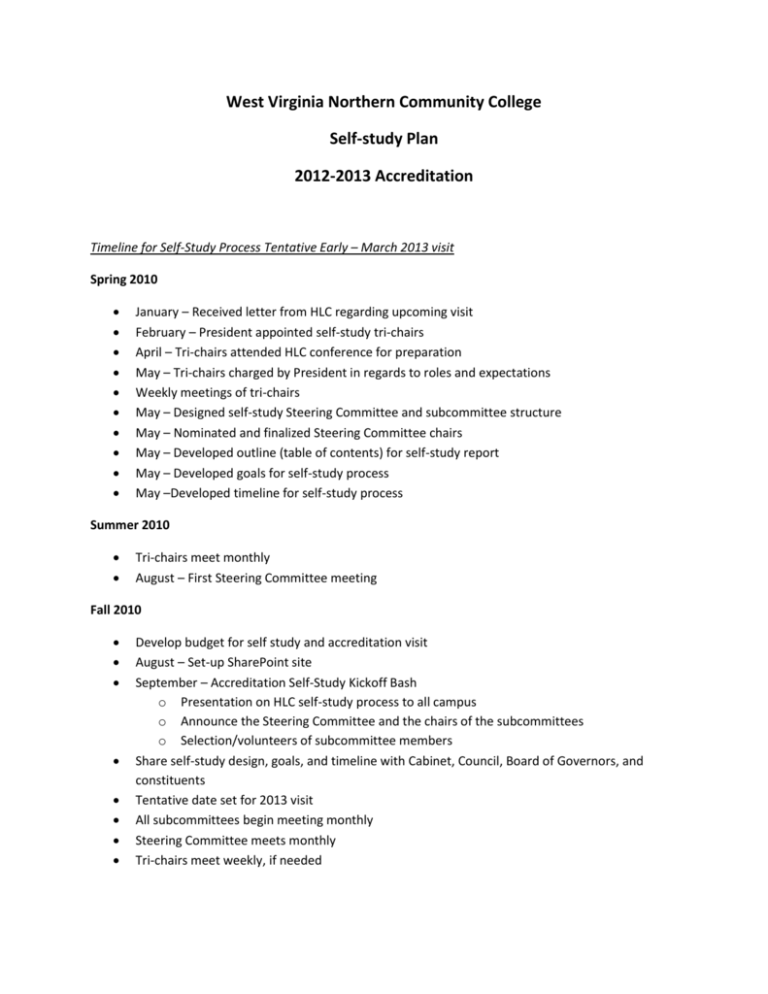
West Virginia Northern Community College Self-study Plan 2012-2013 Accreditation Timeline for Self-Study Process Tentative Early – March 2013 visit Spring 2010 January – Received letter from HLC regarding upcoming visit February – President appointed self-study tri-chairs April – Tri-chairs attended HLC conference for preparation May – Tri-chairs charged by President in regards to roles and expectations Weekly meetings of tri-chairs May – Designed self-study Steering Committee and subcommittee structure May – Nominated and finalized Steering Committee chairs May – Developed outline (table of contents) for self-study report May – Developed goals for self-study process May –Developed timeline for self-study process Summer 2010 Tri-chairs meet monthly August – First Steering Committee meeting Fall 2010 Develop budget for self study and accreditation visit August – Set-up SharePoint site September – Accreditation Self-Study Kickoff Bash o Presentation on HLC self-study process to all campus o Announce the Steering Committee and the chairs of the subcommittees o Selection/volunteers of subcommittee members Share self-study design, goals, and timeline with Cabinet, Council, Board of Governors, and constituents Tentative date set for 2013 visit All subcommittees begin meeting monthly Steering Committee meets monthly Tri-chairs meet weekly, if needed Spring 2011 Subcommittee tentative chapter plans due to tri-chairs by May 2, 2011 Tri-chairs and select Steering Committee members attend HLC conference Subcommittees continue meeting monthly Steering Committee meets monthly Tri-chairs meet weekly or monthly as needed Tri-chairs send self-study plan to HLC liaison Summer 2011 Tri-chairs complete general sections of self study by August 1, 2011 Tri-chairs meet monthly Fall 2011 All College Day update on self-study progress October – Subcommittees complete outlines of chapters October – Tri-chairs set timetable for completion of chapters and individuals responsible for each task for each committee Subcommittee meetings monthly Steering Committee meets monthly Tri-chairs meet weekly if needed Spring 2012 Room reservation for on and off-campus meetings March 1 – Each chair submits draft of their section to tri-chairs April – Tri-chairs and select Steering Committee members attend HLC meeting May 1 – first draft of self-study report completed Committee Meetings Monthly Steering Committee meets monthly Tri-chairs meet weekly if needed Summer 2012 Committee discussions by email or SharePoint, if needed Tri-chairs meet weekly if needed Fall 2012 August – All College Day – What everyone needs to know about visit in “March”: Criteria, timeline, what to expect Tri-chairs meet weekly if needed August – Draft submitted to subcommittees for review and comment September – Draft submitted to faculty, staff, Cabinet, and Board for review and comment October – Revisions made by Tri-chairs October – Send draft of self study to HLC liaison November – Final draft distributed for last chance revisions December – Publicity committee formats final version of self study Evaluate proposed roster of visiting team members and send response to HLC Confirm hotel accommodation HLC sends Evaluation Visit Summary Sheet Begin arrangements for accreditation team visit Final version of self study complete Final production and printing of self study College-wide area/departmental informational meetings to prepare for site visit Announce dates of visit to all constituent groups including external constituents Announce dates of visit on website and in other publications Spring 2013 January 7 – Final report and materials mailed to team and HLC Liaison Confirm campus room reservations, including Resource Room Verify completion of virtual Resource Room Post final self-study report on SharePoint January – Submit self-study report 8-10 weeks prior to team visit Visiting team chair contacts President to confirm arrangements January – pay invoice for team visit Share self-study results with campus community to assist in strategic planning? College-wide area/departmental informational meetings to prepare for site visit Publicize open meeting with HLC team February – Complete physical and virtual Resource Rooms February – finalize team schedule and confirm with team chair Team visit – mid-March April – Team chair sends draft of team report to WVNCC within six weeks of visit Send institutional response within two weeks of receipt of Draft Team Report May – Team chair sends Final Team Report to Commission Commission staff sends Final Team Report to WVNCC Send institutional response within two weeks of receipt of Final Team Report Celebration event Goals Following are the goals set forth for WVNCC’s 2012-2013 self-study process and report for reaccreditation: Produce, through deliberation and reflection, a candid self-study report that enhances accountability to both internal and external constituents. Inform the College of the emerging needs of future learners to foster development of strategies that meet those needs. Analyze programs and services to identify strengths and challenges in relation to future trends that will guide development of strategies for improvement, planning, and decision making. Demonstrate fulfillment of Criteria for Accreditation and Core Components. Review and clarify the College’s communication processes to advocate institutional improvement and student learning. Fit Between Self-Study Process and Institutional and Commission Needs The self study process at West Virginia Northern Community College is designed to produce a self-study report that meets the Commission’s and institution’s needs. The Commission needs an evaluative document with clear patterns of evidence that demonstrates the institution is fulfilling the five criteria for accreditation and associated core components and which leads to continuous improvement. From an institutional perspective, the process should be a comprehensive assessment which delineates institutional strengths and areas for improvement. Northern wants the self-study process to link to strategic planning and to its institutional effectiveness program. The committees have been established with a crossfunctional composition, and this will contribute to both a comprehensive approach and a critical evaluation. The use of a web site to house committee work ensures that the process is transparent and is intended to foster college-wide discussion about the findings. All committee chairs will receive training and resource materials on the criteria and core components, and one of the tri-chairs of accreditation serves as a liaison to each of the committees to ensure that they focus on patterns of evidence for the criteria. The dependence on data for the study will help reinforce the College’s efforts to become more data-driven in decision making and planning. The self-study process is interwoven with the institution’s strategic plan, and feedback processes will be established so that findings from the committees can be linked to planning and improvement of institutional effectiveness. Proposed Committee Structure Dr. Martin Olshinsky, President Becky Yesenczki, Administrative Associate: Chair, Resource Room Mike Koon, Accreditation Liaison & VP of Economic & Workforce Development Self Study Coordinators Lisa Soly, Counselor: Chair, Criterion 1 Debbie Folger, Associate Professor: Chair, Criterion 2 Chris Kefauver, Assistant Professor: Chair, Criterion 3 Lisa Ingram, Associate Professor RCT Christina Sullivan, Retention Coordinator Lucy Kefauver, Executive Administrative Assistant to the VPAA: Chair, Criterion 4 Committees Headed by Coordinators Steering Committee Larry Tackett, Campus Dean: Chair, Criterion 5 Publication Ralph Lucki, Professor: Chair, Federal Compliance History of Accreditation Committee Self Study Process Debbie Cresap, Instructor: Chair, Change Request Dr. Vicki Riley, VP of Academic Affairs Significant Changes/ History Jonathan Dickerson: Student Representative Ex-officio Members Tom Danford, Professor & Assessment Coordinator IT/IR Rep Hilary Curto, Graphic Arts Designer, Community Relations Working Outline of Self-Study Document I. II. III. IV. Introduction a. History of WVNCC b. Overview of Service Region c. Overview of Student Population d. Overview of State College & University System e. Significant Changes since last Visit Self-Study Process a. Purpose of Self-Study b. Self-Study Goals c. Process of Self-Study d. Timeline e. Self-Study Steering Committee Structure i. Tri-Chair Role ii. Steering Committee iii. Committee Membership f. History of Accreditation g. Focus Visit h. Response to Concerns of Previous Visit Criterion One: Mission and Integrity a. Core Component 1a: The organization’s mission documents are clear and articulate publicly the organization’s commitments. b. Core Component 1b: In its mission documents, the organization recognizes the diversity of its learners, other constituencies, and the greater society it serves. c. Core Component 1c: Understanding of and support for the mission pervade the organization. d. Core Component 1d: The organization’s governance and administrative structures promote effective leadership and support. e. Core Component 1e: The organization upholds and protects its integrity. Criterion Two: Preparing for the Future a. Core Component 2a: The organization realistically prepares for a future shaped by multiple societal and economic trends. b. Core Component 2b: The organization’s resource base supports it educational programs and its plans for maintaining and strengthening their quality in the future. c. Core Component 2c: The organization’s ongoing evaluation and assessment processes provide reliable evidence of institutional effectiveness that clearly informs strategies for continuous improvement. V. VI. VII. VIII. d. Core Component 2d: All levels of planning align with the organization’s mission, thereby enhancing its capacity to fulfill that mission. Criterion Three: Student Learning and Effective Teaching a. Core Component 3a: The organization’s goals for student learning outcomes are clearly stated for each educational program and make effective assessment possible. b. Core Component 3b: The organization values and supports effective teaching. c. Core Component 3c: The organization creates effective learning environments. d. Core Component 3d: The organization’s learning resources support student learning and effective teaching. Criterion Four: Acquisition, Discovery, and Application of Knowledge a. Core Component 4a: The organization demonstrates, through the actions of its board, administrators, students, faculty, and staff, that it values a life of learning. b. Core Component 4b: The organization demonstrates that acquisition of a breadth of knowledge and skills and the exercise of intellectual inquiry are integral to its educational programs. c. Core Component 4c. The organization assesses the usefulness of its curricula to students who will live and work in a global, diverse, and technological society. d. Core Component 4d: The organization provides support to ensure that faculty, students, and staff acquire, discover, and apply knowledge responsibly. Criterion Five: Engagement and Service a. Core Component 5a: The organization learns from the constituencies it serves and analyzes its capacity to serve their needs and expectations. b. Core Component 5b: The organization has the capacity and the commitment to engage with its identified constituencies and communities. c. Core Component 5c: The organization demonstrates its responsiveness to those constituencies that depend on it for service. d. Core Component 5d: Internal and external constituencies value the services the organization provides. Federal Compliance a. Introduction b. Credits, Program Length, and Tuition c. Transfer Policies d. Verification of Student Identity e. Title IV Program and Related Responsibilities i. General Program Requirements ii. Financial Responsibility Requirements IX. X. iii. Default Rates, Campus Crime Information and Related Disclosure of Consumer Information, Satisfactory Academic Progress and Attendance Policies iv. Contractual Relationships f. Institutional Disclosures and Advertising and Recruitment Materials g. Relationship with Other Accrediting Agencies and with State Regulatory Boards h. Public Notification of and Evaluation Visit and Third Party Comment Request for Institutional Change a. What change is being proposed? i. Specific Change ii. Expected Outcomes of Change iii. Impact on mission, service region, students iv. HLC’s policy relevant to the change b. Why is change being requested? i. What is the relation of the change to institutional planning? ii. Needs analysis iii. Involvement of constituencies in developing the change c. What necessary approvals have been obtained for this change? d. What impact does the proposed change have on past challenges? e. What are the institutions plans to implement and sustain the change? i. Appropriately credentialed, trained faculty and staff ii. Administrative structure in place to support the change iii. Learning resources and support services available to students to support the change iv. Financial Resources available to implement and sustain the change v. Timeline for implementation f. How to evaluate the proposed change? Summary and Conclusion a. Formal Request for Reaccreditation
